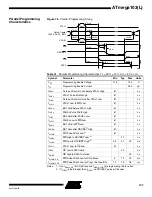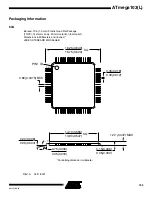
118
ATmega103(L)
0945G–09/01
Typical
Characteristics
The following charts show typical behavior. These figures are not tested during manu-
facturing. All current consumption measurements are performed with all I/O pins
configured as inputs and with internal pull-ups enabled. All pins on Port F are pulled high
externally. A sine wave generator with rail-to-rail output is used as clock source.
The power consumption in Power-down mode is independent of clock selection.
The current consumption is a function of several factors such as: operating voltage,
operating frequency, loading of I/O pins, switching rate of I/O pins, code executed and
ambient temperature. The dominating factors are operating voltage and frequency.
The current drawn from capacitive loaded pins may be estimated (for one pin) as C
L
•
V
CC
• f, where C
L
= load capacitance, V
CC
= operating voltage and f = average switching
frequency of I/O pin.
The parts are characterized at frequencies higher than test limits. Parts are not guaran-
teed to function properly at frequencies higher than the ordering code indicates.
The difference between current consumption in Power-down mode with Watchdog
Timer enabled and Power-down mode with Watchdog Timer disabled represents the dif-
ferential current drawn by the Watchdog timer.
Figure 81.
Active Supply Current vs. Frequency
0
5
10
15
20
25
30
35
40
45
50
0
1
2
3
4
5
6
7
8
9
10
11
12
13
14
15
ACTIVE SUPPLY CURRENT vs. FREQUENCY
T = 25˚C
A
Frequency (MHz)
I
cc
(mA)
V
cc
= 5.5V
V
cc
= 5V
V
cc
= 2.7V
V
cc
= 3.0V
V
cc
= 3.3V
V
cc
= 3.6V
V
cc
= 4V
V
cc
= 4.5V
V
cc
= 6V
















































